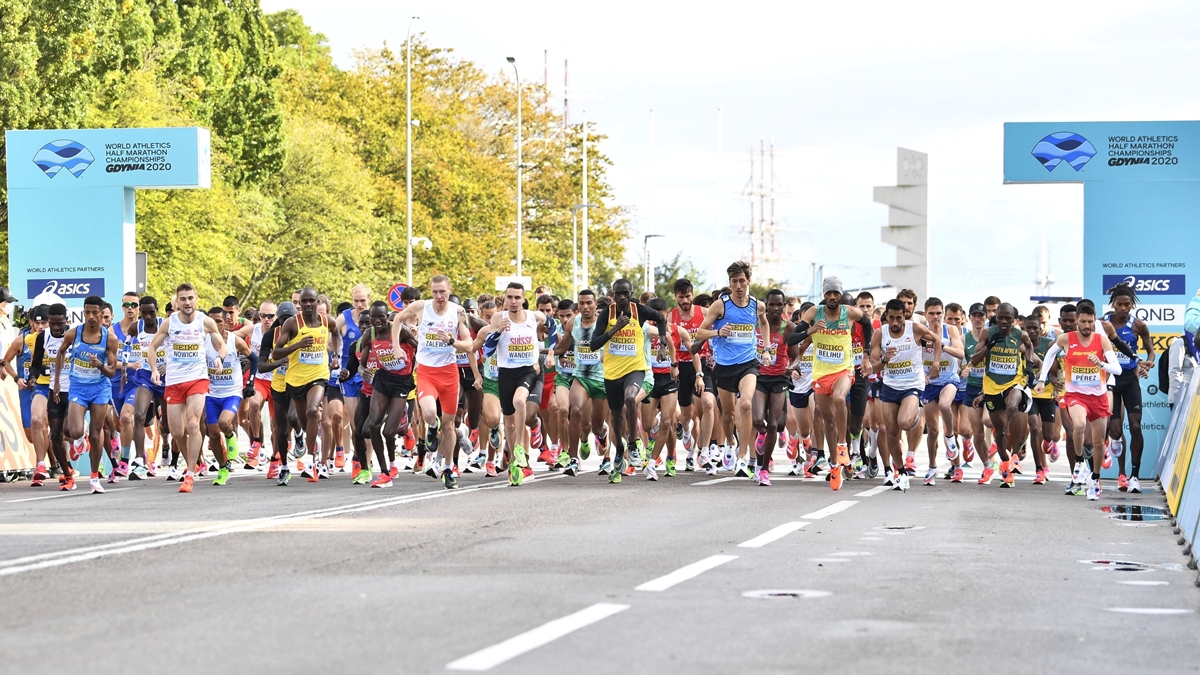Home>Misc>Featured>How To Train For A Half Marathon Trail Run


Featured
How To Train For A Half Marathon Trail Run
Modified: January 22, 2024
Learn how to train for a half marathon trail run with our featured tips and expert advice. Achieve your running goals and conquer the trails in no time.
Introduction
Are you ready to take on the challenge of a half marathon trail run? Breathtaking views, rugged terrain, and a sense of adventure await you on the trails. Whether you’re a seasoned runner looking to test your limits or a beginner eager to step outside the confines of the road, training for a half marathon trail run requires a unique approach.
Unlike running on pavement, trail running offers a variety of challenges, both physically and mentally. From navigating uneven terrain and tackling steep ascents to adapting to ever-changing trail conditions, preparation is key to ensure a successful and enjoyable race experience.
In this article, we will guide you through the essential steps to train for a half marathon trail run. You will learn how to choose the right trail, set goals, create a training plan, build endurance and stamina, tackle hill training, incorporate speed and interval workouts, strength train and cross-train, fuel your body with proper nutrition and hydration, prevent injuries, recover effectively, and mentally prepare for the race.
By the end of this guide, you will be equipped with the knowledge and strategies necessary to take on the challenge of a half marathon trail run with confidence and achieve your personal best. So, lace up your trail shoes, embrace the beauty of nature, and let’s dive into the exciting world of trail running!
Choosing the Right Trail
When training for a half marathon trail run, selecting the right trail is essential to your overall experience. Each trail offers its own unique characteristics and challenges, so consider the following factors before making a decision.
- Difficulty Level: Trails are typically categorized as easy, moderate, or difficult. As a beginner, it’s best to start with an easier trail that has a well-marked path and minimal technical obstacles. Gradually progress to more challenging trails as you gain experience and confidence.
- Distance: While training for a half marathon, aim for trails that closely match the race distance. This will help you become familiar with the terrain and build up your endurance appropriately.
- Elevation Gain: Pay attention to the elevation gain of the trail. If your race includes significant inclines, incorporate trails with similar terrain into your training to prepare your muscles and cardiovascular system.
- Trail Surface: Determine whether the trail is primarily composed of dirt, gravel, rocks, or other surfaces. This information will guide your shoe selection and help you adapt your running form to different terrains.
- Accessibility: Consider the location and accessibility of the trail. Choose one that allows you to train regularly and easily access amenities such as restrooms, water fountains, and parking facilities.
- Scenic Value: One of the greatest attractions of trail running is the opportunity to immerse yourself in nature. Look for trails that offer scenic views, lush vegetation, and peaceful surroundings to enhance your running experience.
Remember to research trail conditions, read reviews, and speak with local running groups or outdoor enthusiasts to get first-hand recommendations. By selecting a trail that aligns with your abilities and goals, you’ll set yourself up for an enjoyable and successful training journey.
Setting Goals and Creating a Training Plan
Before embarking on your half marathon trail run training, it’s crucial to set clear goals and develop a well-structured training plan. By doing so, you’ll have a roadmap to follow, stay motivated, and track your progress along the way.
Start by establishing two types of goals: outcome goals and process goals. Outcome goals are the ultimate achievements you seek, such as completing the race within a specific time or finishing in the top percentile. Process goals, on the other hand, are the daily, weekly, or monthly actions that will propel you towards your desired outcome. These can include running a certain number of miles per week, incorporating strength training, or improving your pace on challenging terrain.
Once you have set your goals, it’s time to create a training plan. Consider the following factors:
- Timeframe: Determine the duration of your training plan, keeping in mind that it typically ranges from 10-16 weeks.
- Weekly Mileage: Gradually increase your weekly mileage to build endurance. Start with a comfortable base and add about 10% each week, allowing for periodic recovery weeks to prevent overuse injuries.
- Long Runs: Incorporate weekly long runs to acclimate your body to the distance. Start with a distance that is challenging but manageable and gradually increase it each week, simulating race conditions.
- Trail Specificity: To prepare for the specific challenges of trail running, include regular trail runs in your training plan. Focus on building strength, stability, and agility on uneven terrain.
- Rest and Recovery: Allocate rest days in your plan to allow your body to recover and adapt. Proper rest is essential for preventing injuries and maximizing performance.
- Cross-Training: Supplement your running with cross-training activities like cycling, swimming, or yoga to improve overall fitness, prevent muscle imbalances, and reduce the risk of overuse injuries.
- Account for Life: Be realistic when creating your training plan and consider your other commitments, such as work, family, and social activities. Flexibility is key to ensure consistency and avoid burnout.
Remember, your training plan is not set in stone. Adjustments may be necessary based on your progress, fatigue levels, and unexpected circumstances. Be adaptable and listen to your body throughout the training process.
By setting goals and creating a personalized training plan, you will set yourself up for success and stay motivated to achieve your desired outcome in the half marathon trail run.
Building Endurance and Stamina
Building endurance and stamina is crucial for successfully completing a half marathon trail run. Since trail running generally requires more effort and energy compared to road running, it’s important to gradually increase your endurance to meet the demands of the race. Here are some tips to help you build endurance and stamina:
- Consistency is Key: Regularly engage in aerobic activities like running, cycling, or swimming to condition your cardiovascular system. Aim for at least three to four days of running per week.
- Long Runs: Incorporate one long run into your weekly training schedule. Start with a manageable distance and gradually increase it each week, building up to the half marathon distance.
- Progressive Overload: Gradually increase the duration and intensity of your runs to challenge your body and stimulate adaptation. This can be achieved through adding distance, introducing intervals, or tackling more challenging terrains.
- Tempo Runs: Include tempo runs, also known as threshold runs, in your training. These are faster-paced runs where you aim to maintain a comfortably hard pace for an extended period. This helps improve your anaerobic threshold and teaches your body to sustain a faster pace for longer durations.
- Hill Repeats: Incorporate hill repeats into your training to improve leg strength and stamina. Find a challenging hill and run up it at a hard effort, then jog or walk back down to recover. Repeat several times, gradually increasing the number of repetitions as you build strength.
- Interval Training: Introduce interval training sessions to improve both aerobic and anaerobic fitness. Alternate between high-intensity efforts and recovery periods. For example, sprint for 30 seconds, then jog or walk for 60 seconds. Repeat the sequence several times.
- Rest and Recovery: Allow for adequate rest and recovery days in your training plan. This allows your body to adapt and become stronger. Pushing too hard without proper rest can lead to overtraining and increased risk of injury.
- Gradual Progress: It’s essential to progress gradually to prevent overuse injuries. While it’s important to challenge yourself, listen to your body and avoid sudden increases in mileage or intensity.
Remember, building endurance and stamina takes time. Be patient and trust the process. With consistent training and gradual progression, you’ll notice improvements in your overall running endurance, making the half marathon trail run more achievable.
Hill Training
Hill training is a vital component of preparing for a half marathon trail run. As trail runners often encounter challenging inclines and descents, incorporating hill training into your regimen will help you develop the strength, power, and mental fortitude necessary to conquer those elevation changes. Here are some tips to make the most out of your hill training sessions:
- Find the Right Hills: Look for hills that are similar in gradient and terrain to those you will encounter during your trail run. This will better prepare your body for the specific challenges ahead.
- Warm Up: Start your hill training session with a dynamic warm-up to prepare your muscles and joints for the exertion ahead. Include exercises like leg swings, high knees, and lunges.
- Hill Repeats: Incorporate hill repeats into your training routine. Choose a hill with a moderate incline and run up at a challenging pace. Once you reach the top, jog or walk down to recover. Repeat the sequence for a designated number of repetitions, gradually increasing it over time.
- Focus on Form: Maintain an upright posture and a strong arm swing while running uphill. Take shorter, quicker strides and keep your eyes focused ahead. Engage your core and drive your knees forward to generate power.
- Vary the Intensity: Mix up your hill training sessions by incorporating different intensities. Alternate between running at a steady effort and pushing yourself for short bursts of maximum effort. This will simulate the varying demands of race conditions.
- Downhill Running: Don’t neglect downhill running in your training. It puts different demands on your muscles and helps improve your balance and agility. When descending, focus on maintaining control and using your arms for balance.
- Rest and Recover: Allow ample rest and recovery between hill training sessions to prevent overuse injuries. Listen to your body and adjust the frequency and intensity of your sessions accordingly.
- Progress Gradually: Start with a few hill repeats and gradually increase the number and intensity as you build strength and endurance. Avoid excessive overload to prevent injury.
- Mental Toughness: Hill training not only builds physical strength but also mental resilience. Embrace the challenge and adopt a positive mindset. Visualize yourself conquering the hills during your race, and let the training sessions boost your confidence.
Remember, hill training is an opportunity to push yourself outside of your comfort zone and improve your overall trail running performance. Embrace the challenge, incorporate hills into your training plan, and watch your strength and confidence soar.
Speed and Interval Training
Speed and interval training are essential components of your half marathon trail run preparation. These types of workouts help improve your running efficiency, increase your anaerobic capacity, and enhance your ability to maintain a faster pace for longer durations. Here’s how you can incorporate speed and interval training into your training plan:
- Warm-Up: Begin every speed or interval session with a thorough warm-up to activate your muscles and prepare your body for the increased intensity. Include dynamic stretches, light jogging, and strides.
- Interval Workouts: Interval workouts involve alternating between periods of high-intensity running and recovery. For example, you can do a session of 400-meter repeats, where you run at a fast pace for 400 meters and then jog or walk for a set amount of time to recover. Repeat the sequence for a designated number of intervals.
- Progressive Intervals: Incorporate progressive intervals into your training to gradually increase the length or intensity of each interval. For example, you can start with shorter intervals at a higher intensity and then progress to longer intervals at a slightly lower intensity.
- Timed Intervals: Another approach is to perform intervals based on time rather than distance. For example, you can run at a fast pace for 1 minute and then recover for 1 minute. Repeat the sequence for a desired number of intervals.
- Pyramid Intervals: Pyramid intervals involve gradually increasing and then decreasing the interval distance or duration. For example, you can start with a 200-meter sprint, then progress to a 400-meter sprint, 800 meters, and so on, and then work your way back down. This helps develop speed, endurance, and mental toughness.
- Speed Workouts: In addition to interval training, include dedicated speed workouts in your training plan. These workouts focus on improving your running economy and maximum sprinting speed. Examples include short sprints, striders, or hill sprints.
- Recovery Periods: Allow for adequate recovery between intervals to maintain the quality of your workout and reduce the risk of fatigue-related injuries. The length of your recovery period will depend on the intensity and duration of your intervals.
- Progress Gradually: Start with shorter intervals or slower paces and gradually progress as your fitness improves. Avoid overexertion and listen to your body to prevent injuries.
- Adapt to Trail Conditions: Whenever possible, perform speed and interval training sessions on trails or terrain that closely resemble your race conditions. This will help you adapt and better prepare for the challenges of the trail.
Remember, speed and interval training should be incorporated strategically into your half marathon trail run training plan. Gradually increase the frequency and intensity of these workouts as you progress, and always prioritize proper warm-up and recovery to optimize your performance and minimize the risk of injury.
Strength Training and Cross-Training
Strength training and cross-training are valuable components of your half marathon trail run preparation. They help improve overall fitness, prevent imbalances, enhance muscular strength and endurance, and reduce the risk of injury. Here’s how you can incorporate strength training and cross-training into your training plan:
- Strength Training: Incorporate strength training exercises that target the muscles necessary for trail running, such as the core, glutes, quadriceps, hamstrings, and calves. Examples include squats, lunges, deadlifts, step-ups, planks, and calf raises.
- Resistance Training: Utilize resistance bands, free weights, or weight machines to add resistance and challenge your muscles during strength training exercises. Aim for 2-3 strength training sessions per week, focusing on different muscle groups on different days.
- Functional Movement: Emphasize functional movements that mimic the demands of trail running, such as single-leg exercises, stability exercises, and exercises that target stability and balance.
- Core Strength: A strong core is essential for efficient running and maintaining stability on uneven terrain. Include exercises such as planks, Russian twists, and mountain climbers to strengthen your core.
- Cross-Training: Incorporate cross-training activities into your routine to improve overall fitness and give your body a break from running. Activities like cycling, swimming, yoga, or Pilates can help improve cardiovascular fitness, flexibility, and muscle recovery.
- Flexibility and Mobility: Don’t forget to prioritize flexibility and mobility exercises to maintain supple muscles and prevent muscle imbalances. Incorporate dynamic stretches and foam rolling into your routine to improve range of motion and reduce the risk of injury.
- Active Recovery: Use lighter cross-training activities as a form of active recovery after intense running sessions. This helps promote blood circulation, aid in muscle recovery, and prevent overuse injuries.
- Listen to Your Body: Adjust the intensity and duration of your cross-training activities based on how your body feels. If you’re feeling fatigued, consider incorporating rest or active recovery days.
- Consistency: Consistently include strength training and cross-training sessions in your training plan to reap the benefits. Make them a regular part of your routine, just like your running workouts.
Remember, strength training and cross-training can greatly enhance your performance and reduce the risk of injury. Find a balance that works for you, and adjust your plan as needed based on your specific goals and training needs.
Nutrition and Hydration
Proper nutrition and hydration play a vital role in supporting your training and performance for a half marathon trail run. Fueling your body with the right nutrients and maintaining adequate hydration will optimize your energy levels, enhance recovery, and help you perform at your best. Here are some key nutrition and hydration tips:
- Caloric Needs: Determine your daily caloric needs based on your training intensity, duration, and individual factors. Aim for a balanced diet that includes carbohydrates, protein, and healthy fats to provide the necessary energy for running and recovery.
- Carbohydrates: Carbohydrates are the primary fuel source for endurance activities. Include complex carbohydrates like whole grains, fruits, vegetables, and legumes in your daily meals to sustain energy levels.
- Protein: Protein is essential for muscle repair and recovery. Include lean sources of protein such as chicken, fish, tofu, beans, and nuts in your diet to support muscle tissue repair and growth.
- Hydration: Stay properly hydrated before, during, and after your training sessions. Aim to drink enough water throughout the day to maintain urine color that is light yellow to clear. During longer runs, consider consuming electrolyte-rich drinks to replace lost minerals.
- Pre-Run Fuel: Consume a balanced meal or snack that is rich in carbohydrates and easily digestible about 1-2 hours before your run. This will provide the necessary energy and prevent digestive discomfort during your training.
- During-Run Fuel: For longer runs, consider ingesting carbohydrates in the form of energy gels, chews, or sports drinks to maintain energy levels. Experiment with different products during training to find what works best for you.
- Post-Run Recovery: Refuel your body after your runs with a snack or meal that includes carbohydrates and protein. This will aid in muscle recovery and replenish glycogen stores.
- Listen to Your Body: Pay attention to your body’s hunger and fullness cues, and adjust your food intake accordingly. Everyone’s nutritional needs and sensitivities are different, so find what works best for you through trial and error.
- Consult a Professional: If you have specific dietary concerns or questions, consider seeking guidance from a registered dietitian or nutritionist who specializes in sports nutrition.
Remember, nutrition and hydration are individualized, and what works for one person may not work for another. Experiment during your training to find the right balance of nutrients and fluids that support your performance and keep you feeling strong and energized throughout your half marathon trail run.
Injury Prevention and Recovery
When training for a half marathon trail run, it’s important to prioritize injury prevention and allow for proper recovery. By taking care of your body, you can continue training consistently and minimize the risk of setbacks. Here are some key strategies for injury prevention and recovery:
- Gradual Progression: Avoid sudden increases in mileage or intensity, as this can increase the risk of overuse injuries. Gradually progress your training to allow your body to adapt and build strength.
- Proper Warm-Up and Cool-Down: Always start your runs with a dynamic warm-up to increase blood flow to your muscles and prepare them for the activity. After each run, incorporate a cool-down routine that includes stretching and foam rolling to aid in recovery.
- Listen to Your Body: Pay attention to any signs of pain, discomfort, or fatigue. If something feels off, modify your training or take a rest day to allow for proper recovery.
- Cross-Training and Strength Training: Regularly engage in cross-training activities and strength training exercises to prevent muscle imbalances, strengthen supporting muscles, and reduce the risk of overuse injuries.
- Rest and Recovery: Allocate rest days in your training plan to give your body time to recover and repair. Adequate sleep and quality nutrition are also crucial for proper recovery.
- Incorporate Recovery Strategies: Utilize recovery strategies such as icing, foam rolling, massage, or compression garments to aid in muscle recovery and reduce inflammation.
- Address Minor Issues Promptly: If you experience any minor aches or pains, address them promptly before they develop into more serious injuries. Use appropriate stretching, rest, or seek professional guidance if needed.
- Proper Footwear: Invest in good quality trail running shoes that provide the necessary support, traction, and stability for the terrain you will be running on. Replace your shoes as needed to maintain their effectiveness.
- Balance Your Training: Alternate between different types of runs, such as long runs, speed workouts, and recovery runs, to give your body a varied stimulus and reduce the risk of overuse injuries.
- Listen to Professional Guidance: If you experience persistent or severe pain, it’s important to seek professional guidance from a healthcare provider or physical therapist who can provide specific advice and treatment.
Remember, injury prevention and recovery are essential aspects of your training. Prioritize these strategies to keep your body healthy and strong as you prepare for your half marathon trail run.
Mental Preparation
Mental preparation is just as important as physical training when it comes to tackling a half marathon trail run. The challenges of the trail require focus, determination, and mental resilience. Here are some strategies to help you mentally prepare for the race:
- Visualize Success: Spend time visualizing yourself successfully running the trail race, overcoming obstacles, and crossing the finish line with a sense of accomplishment. Visualizing positive outcomes can help build confidence and motivation.
- Setting Realistic Expectations: Define your goals and set realistic expectations based on your training, abilities, and experience. This will help manage any unnecessary pressure and allow you to enjoy the journey.
- Positive Self-Talk: Practice positive self-talk to build confidence and overcome self-doubt. Encourage yourself with affirmations and focus on your strengths and progress.
- Develop a Mantra: Create a personal mantra or phrase that resonates with you and motivates you during challenging moments. Repeat it to yourself during your runs and especially when facing difficult sections of the race.
- Break the Race Down: Rather than focusing on the entire distance, break the race down into smaller segments or milestones. Focus on reaching one milestone at a time, giving yourself a sense of accomplishment along the way.
- Practice Mindfulness: Incorporate mindfulness techniques into your training to stay present and focused during your runs. Pay attention to your breath, the sensations in your body, and the beauty of your surroundings.
- Adapt to Unexpected Challenges: Trail runs can present unexpected challenges, such as weather, course changes, or technical terrain. Embrace adaptability and focus on finding solutions rather than dwelling on the challenges.
- Stay Positive: Maintaining a positive mindset can make a significant difference in your race experience. Embrace the beauty of the trail, appreciate your body’s capabilities, and stay grateful for the opportunity to participate.
- Buddy System: Training and running with a partner or a group can provide support and motivation. Lean on each other for encouragement and share experiences, making the journey more enjoyable.
- Celebrate Milestones: Recognize and celebrate your training milestones, such as completing long runs or achieving new personal records. This will boost your confidence and reinforce your progress.
Remember, mental toughness and preparedness can make a significant impact on your performance and overall race experience. By incorporating these strategies into your training and race day mindset, you’ll be better equipped to handle challenges and perform at your best during your half marathon trail run.
Conclusion
Congratulations! You are now equipped with the knowledge and strategies to successfully train for a half marathon trail run. By following the steps outlined in this guide, you can confidently tackle the challenges of the trails and achieve your personal best. Remember, trail running offers a unique and adventurous experience that requires both physical and mental preparation.
Start by choosing the right trail that suits your abilities and goals. Set clear goals, create a well-structured training plan, and gradually build endurance and stamina. Incorporate hill training, speed and interval workouts, strength training, and cross-training to improve your overall fitness level.
Pay attention to nutrition and hydration, fueling your body with the proper nutrients and maintaining adequate hydration throughout your training. Prioritize injury prevention and recovery by taking care of your body, allowing for rest days and incorporating recovery strategies.
Mental preparation is key to conquer the challenges of trail running. Visualize success, practice positive self-talk, develop a mantra, and focus on the present moment. Find support through training partners or groups, and celebrate your milestones along the way.
As you embark on your half marathon trail run journey, remember to listen to your body, adapt your training as needed, and stay committed to your goals. Embrace the beauty of the trails, immerse yourself in nature, and enjoy the sense of adventure that trail running brings.
Now, lace up your trail shoes, step outside the confines of the road, and take on the thrill of a half marathon trail run. Believe in yourself, stay dedicated to your training plan, and let your determination guide you to the finish line. Good luck!









